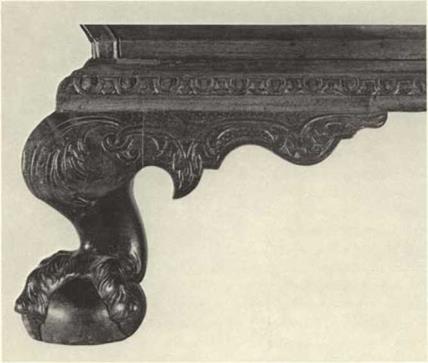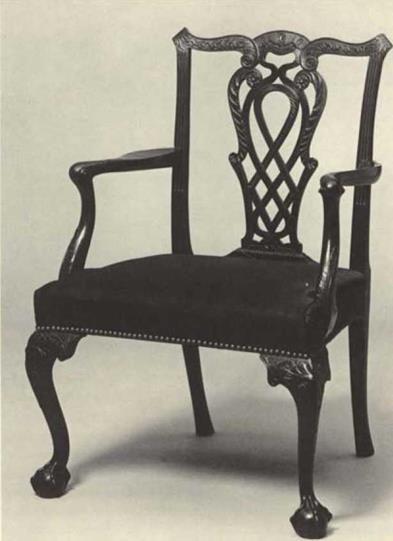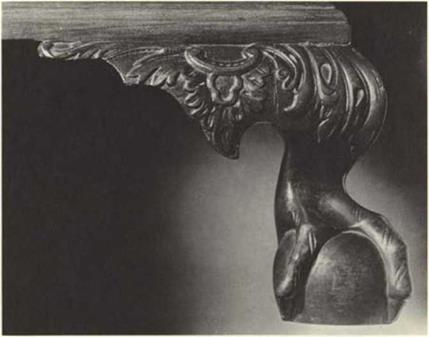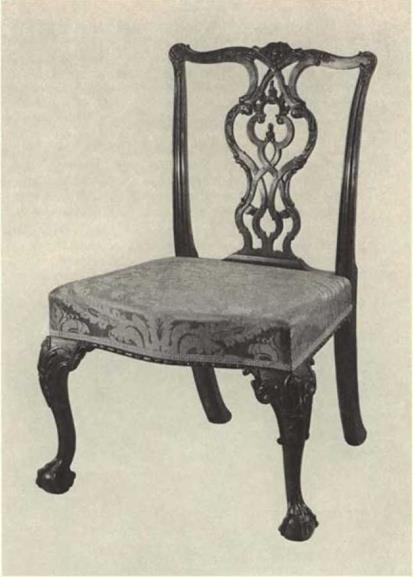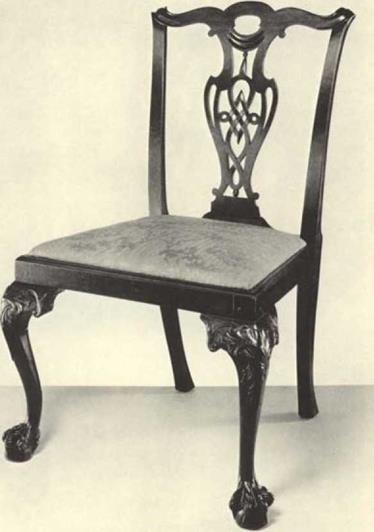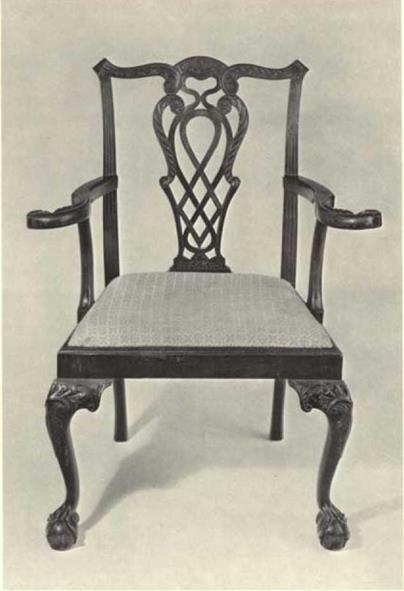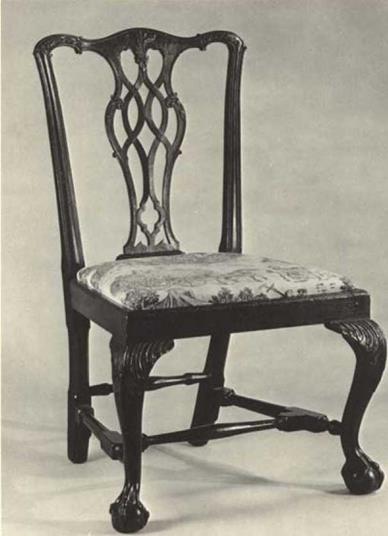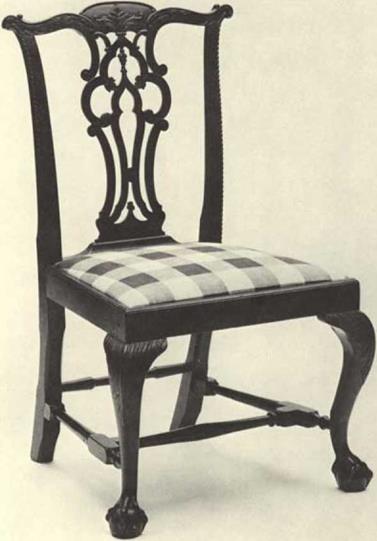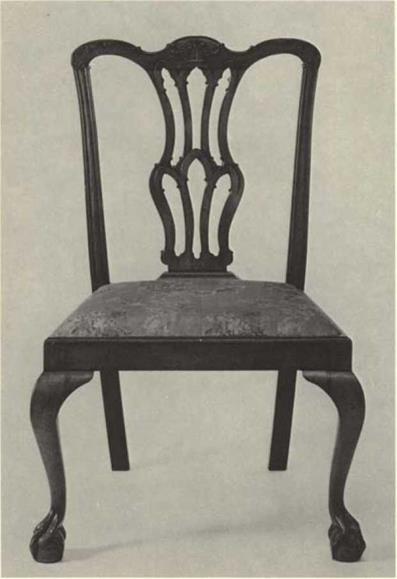ДТ Last throe major furniture carved, each with his own particu – /-Д lar style of carving, worked in Boston between the years J – і t755 and 17Я5. One style of Carving, seen on a chesl-on – chest signed by John Cogswell, is notable for its three-dimensionality arid the wide shallow grooves articulating the surface of the leaves (fig. 139}. Another style, distinguished by two-dimensionality and the thin, narrow grooves used to indicate leaf forms, is evident on a desk and bookcase by George Bright (fig. 140). A third style, seen on a distinctive group of chairs and settees, is notable for its amorphous quality and lack of sharp articulating lines (fig. 141),
Personal and business papers relating to the activities of furniture craftsmen in eighteenth-century Boston are scarce. No record of a transaction between a cabinetmaker and carver in the Chippendale period in Boston has yet come to light. Whether cabinetmakers carved some or all of the products of their shops, hired specialized carvers for individual, specific jobs, or arranged for carving on a contract basis has yet to be discovered. Certainly in the Boston of the 1770s and 17H0S cabinetmakers were the prestige segment of the furniture-making population. It was the cabinetmaker’s name that appeared on a bill for furniture and if any name appeared on a piece of furniture it was more likely the cabinetmaker’s than the earver’s. |[ the cabinetmaker himself did not do the skillfully carved decorations, he certainly took credit for the finished product.
The pre-eminence of the cabinetmaker is well illustrated by the correspondence between David Spear and bis hanede. Mar су Hig-
ІУ7
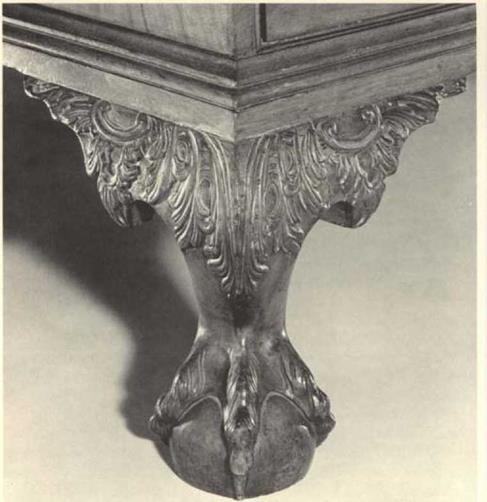 |
 |
gins.1 DaviJ Spear wrote eo Marcy cxdtcdly telling her that bis father was going to get "Mr, bright" to nuke the mahogany furniture for their new home. David was pleased because he knew that George bright was “esteemed the nearest workman in town.” The "very
t. Quoted ill Richard H. UamLIl, Jr,, "Cnurge Brig hr. Cabinet ruikef," T(jC Aft Quaittrly, KKt’ll (lyfU), lift, Ijft.
good Furniture" from Bright’s shop that die Spears were anticipating was probably being, at that very moment, decora ted by someone far less exalted than Mr. Bright—someone who would have received a very small sum for his very skillful services. In the 1780 tax lists for Suffolk County, George Bright and the equally successful cabinetmaker Alexander Edwards were assessed £120 apiece whereas the carver Joshua Bowles paid j£io and carvers Simeon and John Skill in paid only ^20 and £ 15 respectively.
It is comparatively easy to sort, sift, and separate visual data, but no carved work can yet be associated with the name of a known carver. Therefore, this discussion of ornamental carving an Boston furniture emphasizes the carving styles. The names of some craftsmen likely to have executed the carved work will be suggested.
John Cogswell apparently employed more than one carver since carved work of very different styles is found on cascpicces made by this cabinetmaker. The carver of the bracket feer on the signed Cogswell chcst-On-chcsi {fig, 139) favored a general three-dimensional style of carving, with C-scrolls carved in high relief, dense leaves lapping one over the other, and shallow grooves used to articulate the surface of the leaves. Similarly carved feet are found on a chest of drawers at the Museum of Fine Arts. Boston [figs. 128 and 142), which, on the basis of the carving style and construction details, is attributed to Cogswell. A different carver undoubtedly executed the sophisticated decoration applied to the pediment {fig. 143) of the signed Cogswell chcst-on-chcst as the rich, highly threedimensional style of the carving is quite different from that of the carving on the bracket feet.
Another type of three-dimensional carving is seen on,1 side chair in the Museum of Fine Arts, Boston (fig. 144), from the James Prince Mansion in New bury port and probably made for Nathaniel Tracy (1731-1796), a prosperous merchant and previous owner of the house. The chair is part of a set including four Other chairs and a sofa which was exhibited as American at the Girl Scout Loan Exhibition of 1929. (The sob is in the collection of Colonial Williamsburg.) There is now doubt as to the origin of the group of furniture. The
|
NO. Detail qt Carved Foot of Desk and Bookcase. Made by George Bright, {Milieuto oC Fine Arts, Brtttoii. Bequest of Miss Clmrlette Нэгсп, J6.U94,) See also fig. 1J4. |
scat frames arc beech and thin, open scat braces arc used. If the beech can be identified by micro-analysis as American beech, this elaborately carved group offurniture from the В os ton area will present a new area of study in Boston carving of the three-dimensional type.
The craftsman who carved the George Bright desk and bookcase had a distinctive style of his own characterized by an overall two-dl – mcnsioiiality (fig. 140). On the Carved feet and brackets he used long narrow grooves to articulate the surface of sparse, hatchet-shaped leaves. A star-punched background partially fills the Linearved surface, The carving on the bracket is contained by a smooth band along the lower edge.
Two-di mens tonality characterizes much of the carving on Massachusetts Chippendale furniture, but some ornamentation relates directly to the work on the Bright desk and bookcase, A bombf chest of drawers with serpentine front in the Museum of Fine Arts, Boston, has claw and ball feet and brackets with similarly fashioned leaves, a star-punched background, and a smooth band forming a border along the bracket’s lower edge,3 It is unlikely, iiowever, that the two pieces of furniture were carved by the same hand for different punches were used on the two backgrounds and the smooth bordered edge extends much further along the bracket on the chest than on the desk and bookcase. The similarities suggest that the craftsman who executed the carving 011 the chest was familiar with, if not trained by, the craftsman responsible for die carving oil the Bright desk and bookcase.
The third major style of furniture carving seen in Boston in the Chippendale period appears on a very interesting and sophisticated group of furniture notable for its unusual, asymmetrically designed carved decorations. The group consists of: matching settees in the Winterthur Museum (fig. 145) and the Metropolitan Museum of Art; a card tabic in a private collection; two aim chain and ten side chairs at the Yale University Art Gallery (fig. 141); a side chair at the Winterthur Museum (fig, 146); and an armchair in the collection of Urael Sack, Inc. (fig. 147). For the sake of convenience, Chart 1 lists various pieces of seating furniture belonging to this group, giving secondary woods, construction methods, and pertinent measurements.
The most distinctive feature of the pieces of furniture in this group, a feature rhat they all have in common, is the unusual carved ornamentation on the knees. The decorative motif is markedly asymmetrical. (Most carved designs on American Chippendale furniture are totally symmetrical in spite of the rococo penchant for asymmetry,) It consists of a large C-scrolt with leafy appendages placed
Ї. For Hi illuMfiUuti of tile Mtpmttor-frunt bom be chest, (Єє Edwin J. Hipltiil, Eighteenth-Century Ллктсґіігі dm. Tljf M. and M. Karalik Collection [Cambridge,
w). fig. JJ.
CHART 1
|
Location |
Type |
CotutrurfrPFi,’ woodf |
Measurements |
|
ї. Winterthur |
Armchair |
becth seat frame; thin |
H – 371//. W. ay1//, |
|
jl,8o |
knee with asymmetrical carving; hairy paw feet |
beech open scat braces |
D, 20%’ |
|
з. Israel Sack, Inc, |
Armchair knee with asymmetric*] carving; claw and hall fat |
maple rear seat rail veneered with mahogany; triangular comer Nocks {зУа’Х**//) wirh chin chamfered edge, held in place by 2 round-headed nails %’d. |
H. 37%*, W, 29*, n. lit’ fi lap rail: 20%’ Splat: it. 19%’ w, at rosettes 8%% W, at base 4%/ Jeflf; W. rear 17%’, w. front 22%*, d. 17* H. a/leg: 14%’ |
|
j. Yale Univcrjiiy |
Side chair |
maple seat frame; u^Aife |
*. J7%’, V – 22%*, |
|
1967.28.1 |
knee with asymmetrical carving; claw and hall feet |
pitte tt і angular comer blocks with thin chamfered edge, held in place by 4 round-headed nails %’tL; American blink ash and maple open seat braces held in place with round-headed nails %’d. |
D. lS%’ W. top tail: 20%’ Splat: h, 19%*, w. at rosettes B%’, w. at base 4^’ 5eaf; w, rear 17%’, V. front 22%’, D, J7%’ H a/leg: І+У/ |
|
4. Yale University |
Armchair |
maple seat frame; Arrc/r |
H- )?%’. w. 26 %*, |
|
1567,26 |
knee with asymmetrical Carving; claw and halt Feet |
rear triangular comer blocks (jY/XiYi’) with thin chamfered edge, held in place by 2 round-headed nails %’d.; maple opeh seat brace* |
D. 19 V IV. tap rail: 21 %* ■SpJtrf: n, 19%’. W. at rosettes 9 W, at base j! V Jfdlr W. rear 1#%’, w. front 2$%’, D. lS%’ Hof leg: MV,’ |
|
5. Winterthur |
Side chair |
<vk rear seat rail |
h. І7′. 4t,2i% |
|
52.242 |
knee wirh asymmetrical Carving; hairy paw feet |
veneered with mahogany; triangular comer blocks cherry (3%’Xi1//) with thm chamfered edge, held in place by screws that have replaced original nails |
d, 17%’ V. lap rail: 20%* Splat: ir. 19%’, H. of leg: 14%’ |
|
6. Wirrerthur |
Settee |
maple seat rail and rear legs, |
H. Jtf*. L 57*, d. 24′ |
|
J9.1377 |
knee wirh asymmetrical Carving; daw and ball feet |
also top of scroll arms; cedar top rail, side rail, front and sides of arms; birth brace of top tail; triangular Corner blocks [4 $£X2’/i’) with thin chamfered edge, held in place by 4 roundheaded nails %’d. |
H. of leg: nV |
|
|
N1. Аямеллтв, Boston area, c, 1760-1780. Mahogany. maple, and birch; ". І7У» inches, w, 26l/x inches, P, 19^4 inches, (Yale University An Uallcry, Mabel Bead у (larvati Collection,)
diagonally across the surface of the knee. Beneath the C-scroU hangs a wilted and drooping leaf.
An armchair at Winterthur (fig. 148 and по, l, chart l) seemingly identical to the group of chairs at Yale University (tig. 141 and nos. 3 and 4, chart 1)—with the same asymmetrical knee decoration and the same splat design—proves on closer inspection, however, 10 have been carved by a different hand than a!! of the other pieces of furniture in the group. A close look reveals many subtle differences.
The Winterthur armchair has stiles fluted in an a, b,a pattern with the center flute rising higher than those to the sides. Its carved leafage across the top rail descends to various levels on the rail. The flutes on the splat’s central figure-eight motif are closely spaced and subtly varied in direction to follow’ the curve of the figure-eight.
In contrast, the carving on the set of chairs ar Yale (fig. 141 and nos. 3, 4, chart l) and that on an armchair owned by Israel Sack (fig. 147 and no. 2, chart 1) show a less artistic hand at work. The flutes in the stiles all reach the same height. The carved leafage across die top rail is equidistant from the lower edge of the rail. There are far fewer flutes on die figure-eight motif on the splat and these are rather carelessly arranged.
One may conclude that the chairs at Yale and the chair owned by Israel Sack, Inc., were copied from the chair owned by Winterthur, but copied by a craftsman who was not so particular in carrying out the details of execution. There has long been speculation about whether the Winterthur chair is American, Acting on the authority of an antiques dealer in Massachusetts who told him that the chair was found in a Massachusetts house, Joseph Downs considered the chair as American despite its beech seat frame and traditionally English scat braccs
It seems quite likely that the armchair at Wintcrrhur is English’1 and that it or a member of its set (the Museum of Fine Arts, Boston.
j, JflKph Pnwni, Amtriftm ЙЛІІАпг, Qfjffrt Anne and Chippendale Periods гл the Henry praneii du Peril WinterthuT Museum (New York, 19 Si), no. SJ.
4. Sm літі F. Lewis Hinckley, Directory of the Hiilurif Cabinet I Voods (New Yurt, >S>60)r PP – 1». lSJ.
|
N2. Detail от Carved Foot or Chest от Drawers. Attributed lojolm Cogswell. (Museum of Fine Аги. Помол, Request Maria There» Hurnham Hopltioj, $7.34.) See also fig. 12S. |
owns a seemingly identical side chair) was used as the model for the rest of the furniture in this group, Particularly intriguing in this context are the thick, wide, open seat braces found on the twelve chairs at Yale. It seems as though the Boston ehairmaker attempted to copy not only the design and carving of the English chair, but also its method of construction. The open seat braces on the Boston-made versions are much heavier and cruder than on the imported model, and die Boston ehairmaker refused to abandon his own traditional method of supporting the chair scats with triangular comer blocks, so dial the scats are supported by both open braces and corner blocks. Consistent construction methods indicate that ehairmaker and
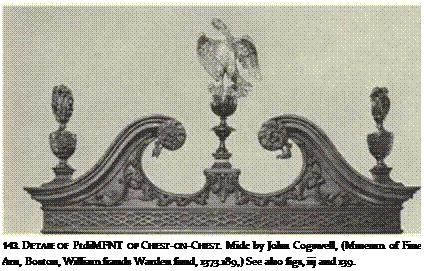 |
carver (and they may have been the same person) worked on all of the members of this particular group of furniture. In each chair and in die settees the maker used triangular comer blocks with thinly chamfered edges, approximately 3 % inches wide, held in place with either four or two large, round-headed nails. The Yale chairs (fig. 141 and nos. 3, 4, chart i) are upholstered over the frame; the Sack chair (fig. 147 and no. 2, chart l) and a side chair at Winterthur (fig. 146 and no. 5, chart l) have slip scats with rear scat rails veneered widi mahogany. Although the splat of the Winterthur side chair is not the same design as that of the other chairs in this group, its cresting rail was made with the same template used for the top rails of the other chairs (they all measure 20% inches in width}. All of the legs belonging to the group of chairs and settees measure 34% inches in height, indicating that the craftsman worked on a piece basis, turning out carved leg after carved leg (thirty-two legs in all). Only the center legs of the settees diflor in style.
More modest types of chairs produced in Boston in the 1770s and 1780s also show interesting carved work by three or more different
|
|
]-14, Sint. Chair. Engtaud сиг Boston ігн, e, 1760-17До, Mahogany and beech; it. J7V* inches, w. 12’/, і tie lies, о, 19 inch». (Museum of" fine Arts, Boston. (lift о Г Mrs. Guy Currier, 15.1577.] Axording to family tradition, this choir wos owned by Xailumicl Troty [1751-1796) cf Ncwbiirypert, Mesfocbufrits.
208 Boston Furniture of the Eighteenth Century
CHART II
|
Lexatiort |
Typt |
Construction; uvwdf |
AfcfljvremmW |
|
l. Winterthur 59.2639.40 |
Side chair, splat A (intertwined scrolls) carved knees, stretchers, daw and ball feet |
pine triangular corner blocks held in place with 2 round-headed nails |
к. j6%% W, 11%’, d, 17%’ W. lop rati: 20′ H. splat: 20’/i’ Central leaf; h. 4 2|% w. iV ‘ |
|
1. Museum of Fine Arts 60.1176 |
Side chair, splat A (intertwined scrolls) canned knees, stretchers, claw and ball feet |
maple scat frame; pittr triangular corner blocks held in place with 1 round-headed nails %’d. |
И. 37% w. 21 %% о, 17і/.’ W. top rail: 13 J/4′ H. splat: 10%’ Central leaf; H. 4 , w. 1%’ |
|
3. Winterthur 64.662 |
Side chair, splat A [intertwined scrolls) Marlborough legs |
no comer blocks; no secondary woods |
H. J<S%% W. 21%’, D. їв’ W, top rail: ip1// H. splat: 21′ Central leaf: h. 4%’, w – ІИГ |
|
4. Metropolitan Museum of An to.12j.2Sv |
Side chair, splat A (intertwined scrolls) Marlborough legs (set of six) |
elterry seat rail; pine triangular corner blocks |
u. 37% w. 11% o. 18′ |
|
5, Winterthur 61,140,1 and 6. Metropolitan Museum of An |
Side chair, splat В (Gothic arch and trefoil) carved knees, stretchers, claw and ball feet |
no comer blocks; no secondary woods |
И – }S w. J31//. d, 19′ W. lap rail: 22%’ H. splat: 21У/ Certfrel leaf: К. 1 w. 4%’ |
|
44-JJ |
|||
|
7, Winterthur JJKW.1 |
Side chair, В (Gothic arch and trefoil) Marlborough legs |
pine rear triangular comer blocks |
h, 38%’. w, 22% D, 19%* W. tap rail: 22%’ И. splat: 22′ Central leaf: tL 2 »^% W. 4′ |
|
8. Metropolitan Museum of An 39,88,2 |
Side cliair, splat C (from ManWaritig) carved knees with punched ground, claw and ball feet |
maple seat rails, pine triangular comer blocks |
It, 38%’. W. J3 %’, D, I?1// |
|
Ornamental |
Carving |
209 |
|
|
Ltk’dfion |
Type |
Construction; woods |
Measurements |
|
9. Massachusetts Historical Society on loan to Muicum of |
Side chair, splat C (from Man waring) carved knees with punched ground, claw and ball feet |
maple teat rails, pine triangular comer blocks, rear (s’xi’/i’). Г™"1 (4%’ХіУ.’)ЬеИЬу4 mils |
K. j»%’. w, 4)%’, D, 17%’ |
|
Fine Arts |
|||
|
1$2-fo |
|||
|
10, Museum of fine Arts Res. 1&.7IS |
Side chair, splat D (two-tiered Gothic) plain knees, claw and ball feet (set of six) |
maple scat Eamc. pirre triangular corner blocks, rear (4.%’Х*УЛ front [i’XiVa’J held by 4 nails |
H. }8X, w. Ї2ijf, D, 19′ |
|
11. Winterthur 54-SJi |
Side chair, splat D, (iwo-riered Gothic) |
pine triangular comer blocks in (tom |
h. jB’, w. 1a1/*’, P. IS1// |
|
pUin клей, daw and ball feet |
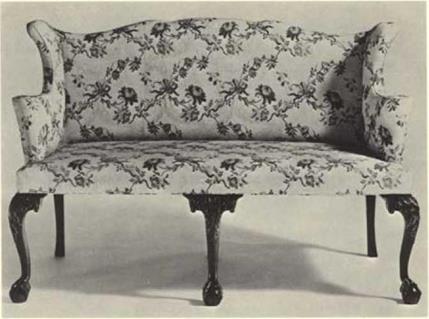 |
145. StTTii. Boston меа. С – 1760-1780. Mahogany, maple, «dir, and birch; h. 36 inches, w. 57 inches, p. 24 inches. {The Henry Francis du Font Winterthur Museum.)
hands, A variety of chairs arranged by splat type зге listed in Chan It giving details of construction, secondary woods, and measurements,
A Boston-made chair popular among those who could afford mahogany furniture was one with a splat of intertwined scrolls, splat a, Examples are located in the Winterthur Museum (no. 1, chart Jl), the Museum of Fine Arts, Boston (fig. uy and no. z, chart n), and the Metropolitan Museum of Art (no. 4, chart ll). Chairs of this type, found frequently in New England, appear not only with ornamental carving, but also in a plain, undecorated form.
Chairs numbers i and 2 (fig, 149) on Chart II with this splat design appear identical to chairs numbers 3 (fig. 130) and 4 with the same splat, hue subtle differences in the size of the carved motifs indicate that the chairs were carved by different hands. Difference in construction further indicate that chairs numbers 3 and 4 were not produced m the same shop as numbers 1 and 2. emphasizing the popularity of the chair design.
Numbers j (fig. 131) and б are two chairs from a large set with unusual splat designs of attenuated C-scroSU, a central Gothic arch, and a small solid rtefoil near die base, splat is. They were probably made by the same chairmaker who fashioned chairs numbers 3 (fig. 130) and 4, or, at least, carved by the same hand.
Chairs numbers N and 9 with splat г (fig, 132) are copied from plate 9 in Robert Man wiring’s The Cabinet and Chair-Alaker’$ Real Friend and Companion (London, 1765), A very differently designed chair with a two-tiered Gothic splat (fig. 133 and no, to, chart и), splat □, shows a similar two-dimensional style of carving and similar construction, making tenable an attribution to the same shop and carver, The carving on the chair with the two-tiered splat relates in its two-dimensional character to that on the Bright desk and bookcase [fig. 140),
Although as yet no carver can be identified with a specific piece of furniture, there is an accumulating body of documentary material relating to a number of craftsmen known to have been working in Boston between 1753 and 1783.
|
|
I-Hi. Sid і Сії лік. Boston area. с. 1760-17K0. Mahogany, oat, and cherry; H. J7 inches, W. at Vj inches, D, t7J^ inches, (The Henry Francis Ju Pont Winterthur Mii – Eum.]
|
|
147. Armchaib. Bottom arti, c, 1760-1780. Mahogany and maple; н. у]’г inches, w. 25 inches, d. inches, (Israel Sack, Ttic., New York City.) According to family tradition, this chair was owned by Elias Hasht Derby (17,30-1799) of Salem.
One of [lie most important identifiable carvers of pre-Re volutionary Boston was John Welch* Born in 1711, Welch is famed for carving che “Sacred Codfish" for the Hall of Representatives in the Boston State House in 1736.5 In 1733 he purchased a lot of land forty by eighty feet in Green Lane, or m Green Street,6 presumably in anticipation of his marriage to the granddaughter of the prosperous carver George Robinson, The association with the Robinson family was an important one for Welch, He may have served an apprenticeship under Robinson, The unfortunate death of Welch’s young wife in 173Й left Welch with a substantial portion of the Robinson estate.7 In 1738 and 1743 Welch increased his holdings in the Green Street area.*1 He made his home on Green Lane, but from 1733 until 1758 he kept a shop on the town dock, a good location for a man who was probably primarily a ship carver.
In 175 R Isaac Dupce, a ship carver, petitioned to have the Use of the “Town’s shop that John Welch occupied."6 in the same year Welch advertised the sale of many household possessions because lie proposed ‘ to go to hngland in a short time.” He did travel to England, presumably on business, but returned to Boston about 1760,™
Tlie 1789 inventory of Welch’s estate indicates that he was involved in the sale of imported looking glasses. A list of shop goods includes a gilt framed glass, a mahogany framed glass, and four looking glass frames as well as carving tools and “5 ps Carved Work,"11 The inventory of his personal property lists “A Marble slab and frame” and "2 Busts,"13 an intriguing reference when one
j, Mibcl M. Swin, "Bitstun’i CljfVrti and Joincti, Part 1, Pre-ReVolutionary," Antiques, l. ni (March, 194*), (?#-
6. Surf. dk County Registry [ifDtrds, Bustim, Massachusetts, XL VII, 196 (hereafter
Stiffs’ll: D«<is}-
7. Sw«i, “Boston*» Carvers and Joiners. Part I,” p. 198.
8. Suffolk Deeds, lvui, 4-й; lxvi, і94-Ч«.
9. Quoted in Swan, "Boston’s Carvers andjuinefs, Part I," p. 199.
10. Ibid.; The Bosh’ii Nru’s-Leftrr. April id, t7j(; Llhe Bralert Caiftte, April 14, 17І®.
11. Suffolk County RejfUtry of Probate, Boston, Massachusetts, docket 191SJ (hereafter Suffolk Probate Records).
11. Ibid.
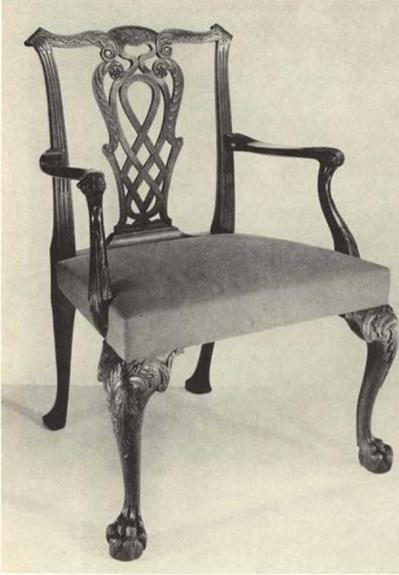
|
recalls the popularity of carved busts as ornaments for cascpictcs m Boston in the 1770s and 1780s.
Welch was a very prosperous carver in pre-Re voluttonary Boston. The list of his household furniture before the 1758 trip to England included: “Large and Small Sconces, Looking Glasses, Chimney and Dressing Glasses, a very handsome japanned Chest of Drawers and Bureau, a Marble topped table supported by Carved Eagles,"[63] [64] Numerous real estate transactions established Welch as a shrewd businessman. In May. 1774, for example, John Welch bought a lot adjoining his own in Green Lane from John Singleton Copley for
153 and resold it a few weeks later for £253.He also had property in the Howdoin Square-Sudbury Street area and in 1780 he paid the large tax of £$0, more than double die sum paid by any other Boston carver,[65] [66]
Most of the other men designated as carvers in public records seem, like Welch, to have been primarily ship carvers. Joshua Bowles and Thomas Luck is had been keeping shop together along the wharf when their inventory was destroyed by the great fire of 1760. They were also engaged in other aspects of the shipping trade for in addition to the "3 Carved heads and carving tools,” they lost two boat masts, fifteen cod and mackerel lines, and three barrels of flour. Uj A bill from Bowles and Luckis to John Hancock further identifies these carvers as ship carvers. Mr. Hancock was charged ^28 for a woman’s bead “7 foot long" and £13 more for brackets, a trail board, and two scrolls.[67] By 1780,Joshua Bowles and Thomas Luckis were working separately. At that time Bowles appears ro have been slightly more successful, but by Luckis’ death in 1808 he had iin-
|
|
M9, Side Chair. Hoston, c. 17*0-1780. Mahogany, maple, and white pine; H. if inches, w. 21% inches. d. 17 V, inches. (Museum of Fine Arcs, Boston, Gift of Mrs. F, Cirri tigtuu Weems, 60.117О. J Ttiii [hair di’xmdtd і гг the Lane family of Boston, ‘ike splat of this eltair is an example of splat Л.
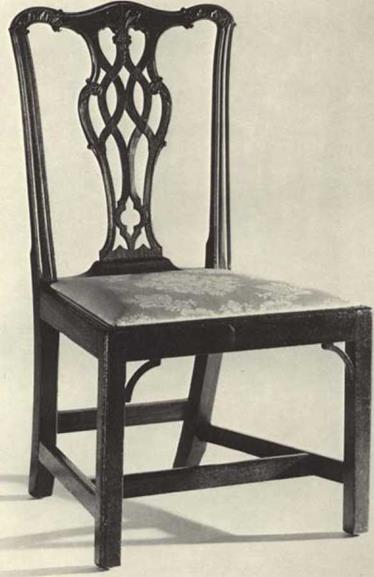
|
|
|
151, Sipe Chau. Poston, e, 17^0-17!)*. Mahogany; H. jK inches, sv.23% inches, u. 19 inches. (The Henry Francis Jit Pont Winterthur Museum.) This (hair A’jrnpcftJ in th Dr і Volf family of Best™. Тік splat t>f this (hair is itrr e. xamptt of splat ІІ.
|
|
152, SiU£ Сплін. Boston от Sdtin, c. і7<5о-і7Я0. Mahogany, пиріг, and white pine; и. з# % indies, чг. * „ inches, d. 17’j inches, (Massachusetts t listonol Society: photo. Ruined CIimIl) i’p/dl C,
|
|
15Э. Stns Склій. Boston, c. 1760-1760, Mahogany. пиріг, md white pine; к, j8 inches, w. zz% inches, d. 19 inches. (Museum of Fine Аги, Boston, Gift of Mary W. Bartol, John W. Bartol, and Abigail W. Clark, Res. a®.?#.) Aeterdmg 10 family iraJinott, fAis fJim’r was owned by James Surapr of Boston and Dot-
f/irflfT, The tplat of this chair il an example of Splat Й.
proved his financial situation and had a house and land on Scotts Court worth 5зооо.1В
Another known carver is Simeon Ski 11 in, Sr., who was in business by 1741 in Salutation Alley.[68] [69] [70] [71] [72] Simeon Skillin’s activities as a ship carver arc well documented but no evidence has been found to show that he carved for cabinetmakers.
Joshua Bowles, Thomas Luckis, and Simeon Skillin may have sometimes carved furniture for the great Boston cabinermakers, but probably they did not permanently associate themselves with one particular cabinetmaker.
One prominent Boston cabinetmaker who may have employed carvers is Alexander Edwards. Although little is known about his life, his economic success in the cabinctmakmg trade associates him with a high-style. highly decorated type of furniture.
Alexander Edwards’ father, Benjamin Edwards, a mariner, arrived in Boston m 1716 and three years later bought a large piece of property in Back Street,[73] During his thirty-five years in Boston Benjamin Edwards became a successful merchant, owning at the time of his death in 1731 a "Mansion House" with warehouse and wharf worth ^fioo, four other houses in Back Street, Ship Street, and White Bread Alley, and two Negro slaves.2′
When his father died, Alexander was eighteen years old and still considered a minor. The cabinetmaker Thomas Sherburne, a neighbor, was made his guardian and probably Edwards was apprenticed to Sherburne in the cab і ue (making trade,22 Upon his maturity Alexander Edwards inherited his father’s Back Street property and set up shop there as a "Gentleman-Cabinetmaker-" He was a patriot and in March, 1777, was appointed to a committee of public safety repre-
sentmg Ward 4,23 lh 17&0 lie was taxed tile considerable sum of £120, the same amount as George Bright,^
As with the other Boston cabinetmakers, no carver’s name can be linked to Alexander Edwards. The difficulty of associating known carvers with existing carved furniture is compounded by the inability to readily discriminate in documentary sources among furniture, ship, or sign carvers.
T|, is analytical study lias attempted to isolate the different styles of the craftsmen who carved Boston furniture during the Chippendale period. Eventually, further study may link these styles with identifiable craftsmen and clarify the relationship between carvers and cabinetmakers.
2J. A firjioff of the Retard Commissioners of the City of Boston, Containing the Boston Тріі’п Retards, 1770 rfrrflafJi 1777. xvill (Бічіоп, 1ЙЙ7), і 76-277.
14. "AsicssdIs1 ‘Tjtinj Unuki’," p – IS-

